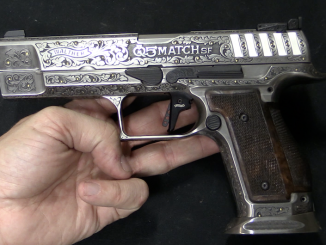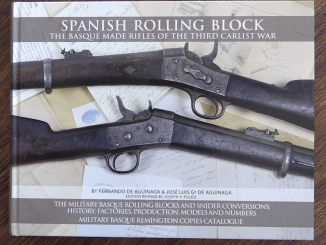The Mauser 98 may have been the best bolt action design of all time, but it did not spring forth from Paul Mauser’s head fully formed. The Mauser took nearly 10 years of development and iteration to reach its full potential, and the 1892 pattern Spanish Mauser we are looking at today is one of the scarcer intermediate variants showcasing that development.
The model 1892 uses a unique improved single stack magazine that can be disassembled using a cartridge case. It also introduced the central safety position for disassembly of the bolt, the long rotary extractor, and a guide rib in the receiver to help smooth the bolt movement.
Spain tested and approved the 1892 pattern, first with a small purchase in 7.65mm and then with a much larger order for rifles in 7x57mm. However, the introduction of the 1893 pattern with its flush double-stack magazine was a significant improvement, and Spain opted to supersede its order for 1892 rifle with 1893s instead. As a result only about 2000 rifles and 400 carbines were actually received in the 1892 pattern.




I could have bad taste, but that single-stack magazine does have a simplicity appeal to it. I do recall that even fixed double-stack magazines need to be crafted properly if you want to avoid feeding problems. Did I mess up?
The problem is that for a single-stack magazine to be (re)loaded in the weapon without using some sort of slow push-and-turn motion (see the Winchester ’95s other then the Russian contract model, or box-magazine bolt-action shotguns), one needs a mechanism that will allow cartridges to be simply pressed in, then reliably retain them and feed them into the chamber, where a double-stack magazine simply requires properly-shaped solid fixed feed lips, i.e. no extra moving parts.
Absolutely no mess up.
The dimensions and geometry of the feed lips are critical when you are pushing cartridges out of a magazine and straight into the chamber.
Whether the mag is feeding from a single position or alternate sides.
This is one reason why so many designers built the feed lips into the gun itself (Mauser, Tokarev, Bergman, Mannlicher’s fixed mag pistols, Schaunauer… to name a few)
They had better control of tolerances on the one piece receiver,than they didid with two or more pieces of metal
and the feed lips were safely hidden away from being used as a hammer or a bottle opener
Sheet metal feed lips come into their own as a cost saving measure when for example one standard size bolt action sporter receiver is expected to be made up into guns chambering cases from .222 headsize to .404 Jeffery head size.
With the availability of CNC or even of investment casting, even the cost saving excuse for a separate piece of bent sheet metal forming the feed lips, begins to appear dubious.
Single stack magazine, as much as it appears to be simpler, it is not as easy to operate bolt action with as a double stack one. And it does not make much difference if lips are machined into receiver or are part of removable magazine body (providing they are not abused).
The reason is that at two lips contact with cartridge there is lot more friction to overcome, irrespective theory which says that contact area does not have effect on friction force. I have some personal experience in that direction, after which I’d definitely prefer double stack feed.
Thanks for your input. I guess it boils down to crafting and usage. En-bloc clips can make single stack magazines easier to load since the clips function as the feed lips, but this depends on well-crafted clips. Double stack magazines are easier on the user, but require more work on the manufacturing end. There is no “universal solution” for this particular issue, not even if one uses interchangeable magazines. I could be wrong.
You are right: with manufacturing finesse and user’s skill everything goes better.
Were 1892 or 1891 used in the US 1892 rifle trials? There were three Mausers in the test that came in second to the Krag, the Krag being considered superior I think only because of it’s single shot capability.
I’ll check up with the US Trials. IIRC it was the Belgian model of 1889 that finished alongside the Krag & Jorgensen and Lee.
So, front locking, dovetailed extractor fixed to the bolt, and a more complex stripper fed single column mag.
The single stack 1902 Springfield prototype actually looks like the Bastard offspring from a drunken one night stand between a Mauser 1892 and a Krag and Jorgensen 1892.
The 1903 Springfield introduced a few Mauser 1893 ideas to the unfortunate mongrel that was adopted.
I can find NOTHING on Rock Island’s website about this gun or which auction it is in! NOTHING!! Very frustrating!
I have one of these that an O.G.C.A director found in a hardware store in New York City in the 1920’s as a youg man. Purchased it from his estate in the early 80’s. Taken off a Spanish shop attempting to run the blockade around Cuba, 1898. It is in the correct production series, the unique Gew 88 pattern sight,no crest and came with its original sling.
IIRC the model of 1892 also introduced lugs rather than screw threads to attach the cocking piece to the firing pin.
Apparently the screw threads of the 1889 had proven to be subject to incorrect reassembly by troops (I’ll guess that that was by Otterman troops rather than by Belgians or Belgian colonials, as the Belgians kept the 1889 right up into the war to make a world safe for Stalin, Mao, Pol Pot, Kim).
The lug attachment can only fit together correctly, or not at all.
Unfortunately the lug attachment system brought different problems,
The minor problem is that of a cushioned firing pin impact on the primer.
The weight of the cocking piece gets dragged along with the firing pin, slowing down lock time, but it isn’t there at the point of contact with the primer, because of the clearances in the joint it has to play catch up, spreading the impact energy out over a longer time and cushioning the blow.
The major problem is the stress concentration in the reduced thickness parts of the firing pin and the sharp corners of the lugs.
Almost all of the front locking Mauser rifles you are likely to encounter, have the dry firing stop surfaces inside the bolt sleeve.
Some institutional users had training drills that included dry firing. I think that the Wermacht were a major offender (I always cringe when someone dry fires!)
The hard impact against the stop surfaces (rather than the cushioned impact when putting a dent into a primer) could cause fatigue in the stress concentrating sharp corners in the lug joint.
A firing pin that was cracked part way through, could sometimes let go when the bolt was being closed, causing out of battery firing, and causing at least serious hand injuries and probably far worse.
This problem was decided to be sufficiently severe for it to be addressed in the 1898 rifles in around 1908.
Themanufacture of the mainspring collar on the firing pin was changed to leave two blades on its front end
And a large oblong gas vent hole in the forward end of the bolt body gave access for a matching cut to be made where the diameter of the firing pin hole reduces.
The changes prevented a snapped firing pin from reaching the primer unless the bolt was in the locked position. It protected the firer from out of battery discharge, but did not protect whatever was infront of the muzzle from accidental discharge.
The problems of correct assembly, cushioned impact on the primer and of metal fatigue and out of battery discharge from a snapped firing pin, we’re elegantly addressed in the 1917 prototype upgrades to the Mauser 98 by both the Mauser Werke in Obendorf (under Fidel Federle), and by Steyr.
The Arisaka type 38 and type 99 one piece hollow firing pin was adopted.
The seperate cocking piece and it’s troublesome joint were dispensed with and the complex bolt sleeve became a much simpler bolt cap but in both instance still incorporating a three position flag safety.
There was no need for lugs on the mainspring flange to stop it from going forward before the bolt was locked
The dry fire stop surfaces were moved to the front of the striker
And on firing, the full energy of the moving one piece firing pin arrived at the primer as a single event.